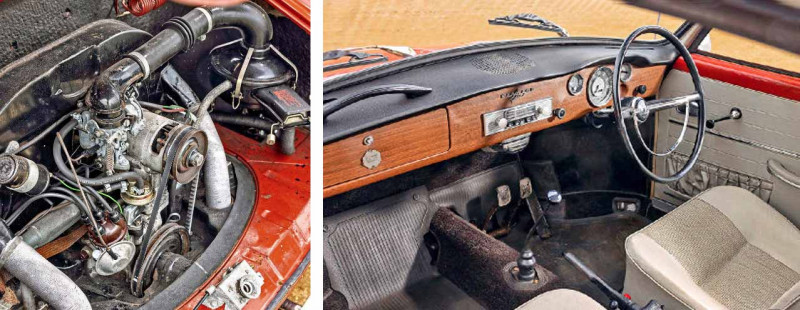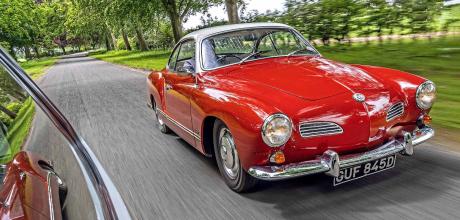1967 Volkswagen Karmann-Ghia 1500
Is this a sports car or just a Beetle in a tuxedo? It’s odd, but no other car in this group – not even the Golf GTI – has quite such a weight of expectation hanging over it quite like the Karmann-Ghia. Given that the Beetle on which it’s based was a Ferdinand Porsche design, and the 356 was created using much of the same thinking and raw materials. Even the Karmann-Ghia’s suspension layout with torsion bars front and rear is similar. Is this sporty coupé and roadster take on the Beetle a decent substitute for a real Porsche? If so, £6k for an average one never looked so cheap.
Early signs are good. The driving position is low and snug, set at a similar height to the 356’s. You sit with your legs straight out, rather than the slightly perched position you adopt in a Beetle, so the gear lever ends up cranked – again, like a Porsche’s – to get it closer to the driver. The feel of the floorhinged pedals underfoot is, again, just like a 356’s. Naturally, the flat-four’s throb is similar too, and the action of that cranked gearlever is actually shorter-travel and more precise than anything Porsche managed in the Sixties.

Pull away, and the sportiness continues. The Beetle’s sense of off-the-line traction is enhanced yet further by sitting so much closer to the centre of gravity in the Karmann. You feel the rear wheels bite the tarmac so much closer to the base of the spine. Pitch it into corners and it doesn’t roll like a Beetle; it scythes. That said, the steering lets the side down. The Karmann-Ghia’s worm-and-roller setup feels distant and vague. There’s no scope for mid-corner adjustment here – you pick your line and hold it. That said, you could say the same of an early 356. Ultimately it’s nowhere near as quick as even a pre-A 356 with the same kind of 1.5-litre displacement – this 1967 Karmann-Ghia 1500 takes nearly 22 seconds to get to 60mph and tops out at 87. Even in the context of its time it’s sluggish – the MG BGT carried a near-identical price tag and offered 12.8 and 105. But to hang the Karmann-Ghia’s appeal solely on its sporting ability is to miss the point. Instead, immerse yourself in its era.
In the Fifties, this car was Ghia chief stylist Luigi Segre’s idea. Several designers laid claim to it, but it was Segre who also masterminded the Ghia-Chryslers beloved of the Rat Pack. And those cars weren’t exactly built to conquer the Nordschliefe. In the context of 1955, that Ghia badge meant exquisite good taste. The Karmann coachbuilders’ plate on the front wing spoke of exclusive handbuilt BMW coupés. Inside, the familiar VW dial sits not in body-coloured steel, but a full-width strip of wood veneer. It’s the kind of mass-market exclusivity that became passé to the point of tacky by 1975 when the Karmann- Ghia finally bowed out. But in that pre-ironic era of Ian Fleming novels, Frank Sinatra films and a craze for hosting black-tie dinner parties in the suburbs, the Karmann-Ghia was a car for arriving in. A handbuilt luxury coupé from an Italian design house? What an incredible statement to emerge from onto Acacia Avenue’s streetlit twilight, clad in the finest crushed velvet C&A could muster, and all for the price of a Ford Corsair. Problem for VW was, Ford eventually hit back with the Capri.
Time and classic appeal has cleansed the Karmann-Ghia of the naffness it was lumbered with in the Eighties – think of the knackered example Molly Ringwald drove in Pretty In Pink – and now decent coupés start at £6k, rising to £20k for the best, with convertibles carrying a £2k premium throughout.
Unlike Beetles and Campers though, they’re trickier to restore. The vagaries of handbuilt construction mean that some trim details lasted for as little as three months at times. The biggest change came in 1961 when the headlights were repositioned, leaving early cars with the ‘lowlight’ tag although they don’t carry the cachet of a split-screen Beetle or Camper. As a result, finding the correct parts for a particular car can become a prolonged feat of autojumbling, and many end up as bitsas, or conspicuously missing strips of chrome. With no extended production in Latin America there’s no handy supply of new old stock body panels either, so bodywork needs repairing rather than replacing, otherwise you’re looking at potentially ill-fitting reproduction parts for four-figure sums even before installation and painting is factored in.
‘Classic appeal has cleansed it of the naffness it was lumbered with in the 1980s’
Owning a Karmann-Ghia
Pete Morley runs Californian Classics, Europe’s biggest Karmann-Ghia specialist. ‘I restore them because I know every aspect, of them, inside and out,’ says Pete. ‘Only the original-shape Karmann-Ghia though – I haven’t done a “razoredge” yet [the larger Type 34 four-seater version which supplemented the original 2+2 in the Sixties], I’d have to do one just to get to know the car. ‘Ownership-wise, they’re half-and-half between a Beetle and something handbuilt and rare. Karmann changed the specification a lot, and some parts are expensive because they were used on some much more prestigious cars. It shares its rear numberplate plinth with the Aston Martin DB5, for example, and its door strikers with the Porsche 356. We make these parts ourselves because they’re no longer available and the prices of used items is outrageous because of these connections with other cars.’
TECHNICAL DATA 1967 Volkswagen Karmann-Ghia 1500
- Engine 1493cc horizontally-opposed four-cylinder, ohv, Solex 31 Pict 4 carburettor
- Max Power 53bhp @ 4200rpm
- Max Torque 78lb ft @ 2600rpm
- Transmission Four-speed manual, rear-wheel drive
- Steering Worm and roller
- Suspension Front: independent, torsion bars, trailing arms, telescopic dampers, anti-roll bar. Rear: independent, torsion bars, swing axles, telescopic dampers
- Brakes Drums all Round
- Performance Top speed: 87mph
- Acceleration 0-60mph: 21.8sec
- Weight 882kg
- Fuel consumption 29mpg
- Cost new £1098
- Classic Cars Price Guide £6500-£21,000
Flat-four, but don’t expect Porsche thrust Snug, tasteful cabin similar to Karmann BMWs. Sleek and low, but not really a sports car.


